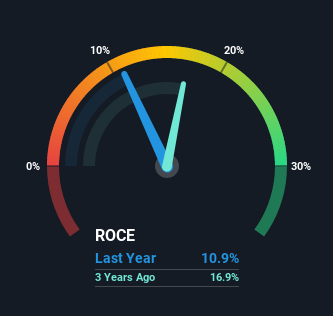- United States
- /
- Luxury
- /
- NasdaqCM:JRSH
Jerash Holdings (US)'s (NASDAQ:JRSH) Returns On Capital Not Reflecting Well On The Business

If you're looking for a multi-bagger, there's a few things to keep an eye out for. Firstly, we'll want to see a proven return on capital employed (ROCE) that is increasing, and secondly, an expanding base of capital employed. This shows us that it's a compounding machine, able to continually reinvest its earnings back into the business and generate higher returns. Having said that, from a first glance at Jerash Holdings (US) (NASDAQ:JRSH) we aren't jumping out of our chairs at how returns are trending, but let's have a deeper look.
Return On Capital Employed (ROCE): What is it?
For those who don't know, ROCE is a measure of a company's yearly pre-tax profit (its return), relative to the capital employed in the business. Analysts use this formula to calculate it for Jerash Holdings (US):
Return on Capital Employed = Earnings Before Interest and Tax (EBIT) ÷ (Total Assets - Current Liabilities)
0.11 = US$6.5m ÷ (US$72m - US$11m) (Based on the trailing twelve months to June 2021).
Thus, Jerash Holdings (US) has an ROCE of 11%. In absolute terms, that's a pretty normal return, and it's somewhat close to the Luxury industry average of 13%.
See our latest analysis for Jerash Holdings (US)

In the above chart we have measured Jerash Holdings (US)'s prior ROCE against its prior performance, but the future is arguably more important. If you'd like to see what analysts are forecasting going forward, you should check out our free report for Jerash Holdings (US).
The Trend Of ROCE
When we looked at the ROCE trend at Jerash Holdings (US), we didn't gain much confidence. Over the last five years, returns on capital have decreased to 11% from 50% five years ago. Although, given both revenue and the amount of assets employed in the business have increased, it could suggest the company is investing in growth, and the extra capital has led to a short-term reduction in ROCE. And if the increased capital generates additional returns, the business, and thus shareholders, will benefit in the long run.
On a side note, Jerash Holdings (US) has done well to pay down its current liabilities to 16% of total assets. So we could link some of this to the decrease in ROCE. What's more, this can reduce some aspects of risk to the business because now the company's suppliers or short-term creditors are funding less of its operations. Since the business is basically funding more of its operations with it's own money, you could argue this has made the business less efficient at generating ROCE.
The Bottom Line
While returns have fallen for Jerash Holdings (US) in recent times, we're encouraged to see that sales are growing and that the business is reinvesting in its operations. And the stock has followed suit returning a meaningful 41% to shareholders over the last three years. So while investors seem to be recognizing these promising trends, we would look further into this stock to make sure the other metrics justify the positive view.
Since virtually every company faces some risks, it's worth knowing what they are, and we've spotted 4 warning signs for Jerash Holdings (US) (of which 1 is significant!) that you should know about.
While Jerash Holdings (US) may not currently earn the highest returns, we've compiled a list of companies that currently earn more than 25% return on equity. Check out this free list here.
New: Manage All Your Stock Portfolios in One Place
We've created the ultimate portfolio companion for stock investors, and it's free.
• Connect an unlimited number of Portfolios and see your total in one currency
• Be alerted to new Warning Signs or Risks via email or mobile
• Track the Fair Value of your stocks
This article by Simply Wall St is general in nature. We provide commentary based on historical data and analyst forecasts only using an unbiased methodology and our articles are not intended to be financial advice. It does not constitute a recommendation to buy or sell any stock, and does not take account of your objectives, or your financial situation. We aim to bring you long-term focused analysis driven by fundamental data. Note that our analysis may not factor in the latest price-sensitive company announcements or qualitative material. Simply Wall St has no position in any stocks mentioned.
Have feedback on this article? Concerned about the content? Get in touch with us directly. Alternatively, email editorial-team (at) simplywallst.com.
About NasdaqCM:JRSH
Jerash Holdings (US)
Through its subsidiaries, manufactures and exports customized, ready-made sportswear, and outerwear through knitted fabrics.
Adequate balance sheet with moderate growth potential.
Market Insights
Community Narratives




